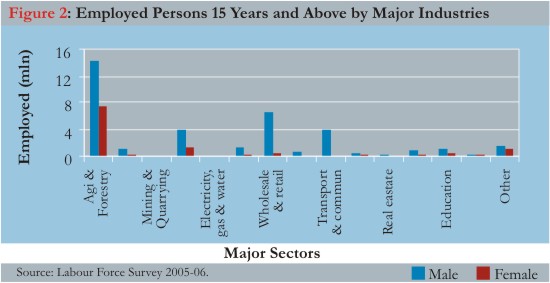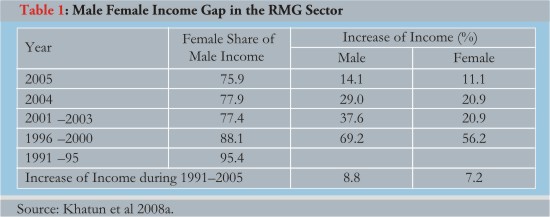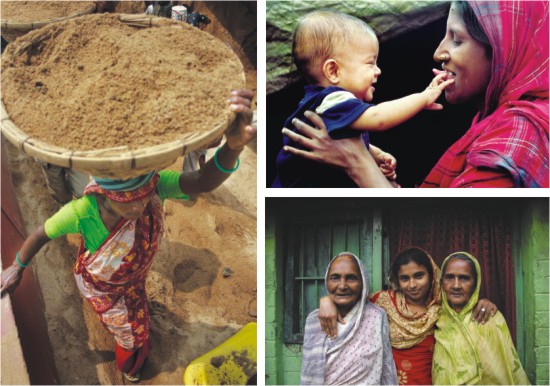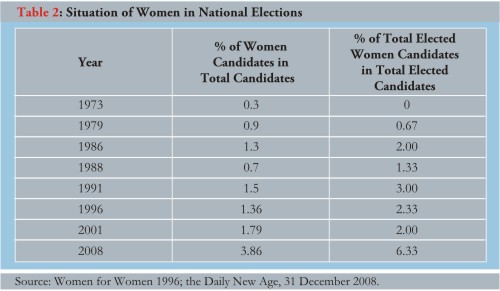
Inside
|
A Woman's Worth Fahmida Khatun pushes for the need to stop paying lip service and start making gender equality a reality in Bangladesh
Being a woman in Bangladesh means a neglected and discriminated existence -- an existence that strives for equality, power, and recognition in a male dominated institution relating to family, society, and the economy. Be it a poor village woman or an educated urban woman, the realities for them are mostly the same -- a subordinate position relative to men both within and outside the household. The lives of men and women contrast in many ways -- in their economic contributions, in allocation of time, income and resources, and in fertility decision-making. The inequality, which prevails between men and women in these areas, is rooted in the existing gender relations, decision-making power, and access to and control of resources. Although the role of women within the household and the community has been changing fast over the past decade or so, their position in terms of prestige, power and control over resources remains almost unchanged. As a result, though the quantitative indicators of changes in women's lives have improved in some cases, qualitative changes have not been remarkable. Participation in labour force and access to gainful employment has increased over time, but education, healthcare and poverty status still remain far below acceptable levels. While development planners and policy makers have recognised the equal role of women and their contribution to the national economy, efforts towards consolidating women's position at the household, community, and national levels have been insufficient. An all- out effort towards improving the welfare of women and bridging the gap between men and women still remains unfinished in the national development and planning. A look at some important indicators will make the situation clearer. Women's Education and Health: As Neglected as Ever Till today, parents prefer spending more for the education of their boys than girls since a boy's education is seen as an investment for the parents' future. Girls' education is useless since they leave their parents' house after they are married, therefore and cannot look after them during their old age. Also, female labour is required for domestic help, therefore parents have no incentive to send them to school.
Though the gross enrolment rate of female student to a male student both at the primary and secondary level is 1.03, this rate declines to only 0.53 at the tertiary level. Adult literacy rate is 44.2 percent for females compared to 56.3 for males. The health indicators show that women are in disadvantageous position compared to men in terms of health and nutrition. While facilities are limited for everyone in general, women's access to such facilities is even more limited. Women's role as wife and mother is glorified, and girls are married off at an early age, especially in the rural areas, and soon after that they enter into a pattern of high fertility. This creates health problems for women. Thirty-six percent of women in the age group of 15-19 are married. Long child-bearing span, with first birth at an early age, and high birth rate (an average of 2.9 children per woman) aggravate women's malnutrition status, which is already poor due to inadequate food intake. Improving the health of women requires addressing social issues. The approach adopted by the health services for women's healthcare is mainly restricted to their reproductive health, while general health remains neglected. The motherhood of Bangladeshi women is characterised by young age, malnutrition, frequent pregnancies, and poor healthcare services. Maternal mortality is 570 per 100,000 women, which is higher than that of India, Pakistan, and Sri Lanka.
Women's Work: An Unbeaten Drum Labour force participation by female has increased to 29.2 percent, according to the Labour Force Survey (LFS) of 2005-06, from 9.4 percent in LFS of 1985-86 (Figure 1). Unemployment rate is higher among women compared to men, though the gap has narrowed over the years. Women's employment is mostly in the agriculture sector (Figure 2). The role of women in agriculture has increased steadily both within and outside their homesteads due to economic pressure and migration of men to the cities in search of better opportunities. The LFS 2005-06 shows that 66.5 percent of the women who participate in the labour force are involved in the agriculture sector. In many areas, such as Dinajpur and Rangpur districts, women also work in the agricultural fields in weeding and harvesting activities. They also take agricultural decisions, such as when to produce what and with what inputs.
Women's participation in the industrial and manufacturing sectors has increased fast since the mid-eighties thanks to the ready-made garments sector, where females make up 80 percent of the labour force. The construction industry absorbs a large number of women. In the manufacturing sector, apart from RMG, export oriented industries such as electronic, pharmaceuticals, garments and shrimp processing have attracted a large number of women. They are also employed in jute and textiles, rice mills, hotels, restaurants and medical clinics. Women's education, skills, kinship ties and age are the important factors for entering into the formal sector. In the informal sector, women are employed in domestic service, construction work, water carrying, sweeping, etc. Informal manufacturing units also employ women in unskilled and low-paid activities, such as making paper bags, jute rope, bidi, etc. In the rural areas, women's participation in gainful activities has increased due to their engagement in various income-generating activities taken up with credit from government and non-government organisations. Double Day, Single Pay The national statistical system fails to get the picture of female labour force by counting only those women who get salaries and those who are looking for a job. Thus statistics imply that women do not work. But the inclusion of all activities performed by women within and outside the household would almost double the contribution of women in the national accounts of Bangladesh (Hamid 1994).
Same Work, Less Money A study by the Centre for Policy Dialogue (CPD) finds that a female operator in an RMG factory earns 71.3 percent of a male operator's earnings, and a female helper earns only 52.7 percent of a male helper's earnings (Table 1) (Khatun et al 2008a). It is often claimed that female workers receive lower wages because they are less educated, less skilled, and less experienced, and thus less efficient or less productive than male workers. However, the CPD study reveals that a female worker with education up to a SSC earns only 87.1 percent of the earning of a male with the same level of education. Landless and poor women work as seasonal, casual and temporary labourers at lower wages than their male counterparts. Women working as day labourers, both in the agricultural and non-agricultural sectors, receive less income than men do for the same work. Feminisation of Poverty However, there has been a remarkable change over the years. The Household Income and Expenditure Survey (HIES) (BBS 2005) shows that the percentage of female-headed household is lower, in the case of both extreme and absolute poverty. In the case of lower poverty line, the percentage of female-headed households is 21.9 and 25.4 percent of male-headed households. Similarly, the percentage of female-headed households in the case of absolute poverty is 29.5 and of male-headed households is 40.8 percent. This is an interesting finding, which reflects that over the years female- headed households have been able to reduce poverty. It also indicates that they spend more on the welfare of their families and thus could improve the poverty situation of their households. Politics: Only Men's Affair? However, there has been remarkable change in terms of women's participation in politics over the last two decades. The country has been run by female prime ministers for the last 18 years. Apart from the female quota, which ensured female presence in local bodies and in the Parliament, women are also being directly elected nowadays by contesting with the male candidates. The participation of female candidates in the election of 2008 has exceeded all previous records. A total of 60 candidates contested directly, out of which 19 won (Table 2). Women are also participating in local government elections. In 1997, a large number of women contested in the union parishad elections, and many of them won. The recent upazila elections also demonstrated the overwhelming participation of women, which was facilitated by reserving the vice-chairmanship for female candidates. Women's participation as voters has also increased significantly in recent years. At present, five important ministries, including the Prime Minister's Office, are being run by competent female parliamentarians. According to the gender empowerment measure (GEM) rank, Bangladesh is placed at 140, a lower position than India, Pakistan, and Sri Lanka (Table 3).
Violence on the Vulnerable: Battered and Bruised for Life Insecurity and vulnerability prevail in the lives of women in Bangladesh -- at home, in the streets and at the workplace. Incidences of divorce and desertion are increasing. The most explicit expression of this insecurity takes place in the form of assault, acid throwing, rape, and trafficking. Though a number of laws have been enacted to protect women's interest and provide security to them, they are yet to feel safe in the family and society. The sufferings of a woman who is violated are both physical and moral, because she not only faces complex legal procedures to get justice but is also looked down upon by the family and society for the rest of her life. Astonishingly, much of the violence is performed within the four walls of the home. Studies show that about 40 percent of the women have been physically abused by their husbands, and about 19 percent of them experienced severe physical violence (Naved et al 2006). Such violence is omnipresent across social strata and economic class. A field-level investigation by CPD among 200 victims of spousal violence in 11 districts of Bangladesh reveals that domestic violence is in fact more prevalent in the middle income and rich households compared to poor households (Khatun et al 2008b). Table 4 shows various types of domestic violence found in the aforesaid study.
The cost of such violence is enormous, and is both direct and indirect in nature. Direct costs are incurred in connection with health care, housing and refuge during displacement, informal shalish, criminal justice and legal services. There are also several hidden costs, which can have long-term psychological impacts on the victim, her family members-- particularly children-- and in the end on the society and the economy, which may affect the gross national product. Breaking the Barriers: Tasks Ahead Towards Empowerment Mainstream gender issues: The empowerment process of women through accommodating women's issues in the national development plans has been slow because, at the policy level, women's issues have always been sidelined and given less priority. Though the national five-year plans and the Poverty Reduction Strategy Paper (PRSP) emphasised women's development, the approach has not been well focused, as women's issues were not recognised as being separate. So far, development strategies such as poverty alleviation, domestic resource mobilisation and human resource development have not spelt out women's role. Women's activities have been supported only through women-specific projects. Major programs and existing institutional facilities such as agricultural extension service, credit programs and banks have not served men and women equally. Allocate more resources: Generally, women's issues are dealt along with other social sector issues such as education, health, population control, family planning and social welfare. Population and family planning have got more importance, and budgetary allocation, than education and health, which are crucial for human development. The social welfare sector receives a small portion of development expenditure; the women's affairs sub-sector gets even smaller. Allocation for women's development in the national Five Year Plans was nominal, as can be seen from Table 5. In the national budget also, allocation for women's development did not exceed little more that 1 percent of the total budget. The government introduced gender equality expenditure in 2007-08, which was 24 percent in the revised budget of 2007-08. Gender equality expenditure has been increased to 26.3 percent in the budget of 2008-09. A bias against women is also reflected in the national budget, where most of the projects and allocations are gender-blind. In recognition of the much-pronounced demand for gender-responsive budget by the non-government organisations, civil society and women activists, the term "Gender Budgeting" was coined in the national budget of 2006-07. Ironically, apart from the lip service, there was not much reflection of increased gender responsiveness in the whole document, except for the usual allocation for the Ministry of Women and Children and allowance for destitute women and widows. In the sectoral allocations for various ministries, particularly agriculture where the contribution of women is huge, projects beneficial to women are almost non-existent. Build policy-making and institutional capacity: As in other cases, problems related to women's development arise primarily because of policy failure and institutional failure. Lack of appropriate and operational policy to lessen and remove the problems of women has been the limitation in the development initiatives for women in Bangladesh. Policies very often do not reflect the need of the concerned groups, or are ad hoc and compartmentalised in nature. Moreover, whatever policies are undertaken cannot be implemented due to lack of institutional capacity arising from resource constraints, both human and financial. The concerned government bodies are not equipped with qualified and able human resources, who can formulate and implement the policies and programs for the welfare of the women. Institutions do not have adequate information, or the arrangements and mechanisms to gather necessary data on the situation of women. These limitations are coupled with lack of adequate financial support. Institutional failure also gives rise to uncoordinated initiatives. The institutions are not empowered with necessary administrative and legal back up. The Ministry of Women's Affairs and the Directorate of Women's Affairs should be strengthened by training manpower and injecting more monetary resources, so that they can decide and act on their own. Initiate participatory process and increase public awareness:
Co-operation and collaboration among the government, non-government and private initiatives can add to the success of women's development programs as each of these has comparative advantage and strengths in it own areas of activities. The implementation of programs, however, will depend on a number of factors, such as availability of adequate funds, proper supervision and monitoring. The importance of community participation cannot be ignored for making the initiatives successful. Therefore, public awareness on gender development and equality through training the policy makers as well as the community as a whole is a prerequisite. Conclusions
We often forget that gender inequality influences the lives and well-being not only of women but also of men, children, family and the society in the end. Unless the aspect of inequality is appreciated and addressed long-term social damage cannot be avoided -- as Professor Amartya Sen says: "Gender inequality is a far-reaching societal impairment, not merely a special deprivation of women. That social understanding is urgent as well as momentous."
Dr. Fahmida Khatun is an Economist at the Centre for Policy Dialogue. References
|










